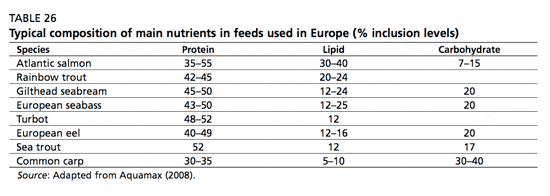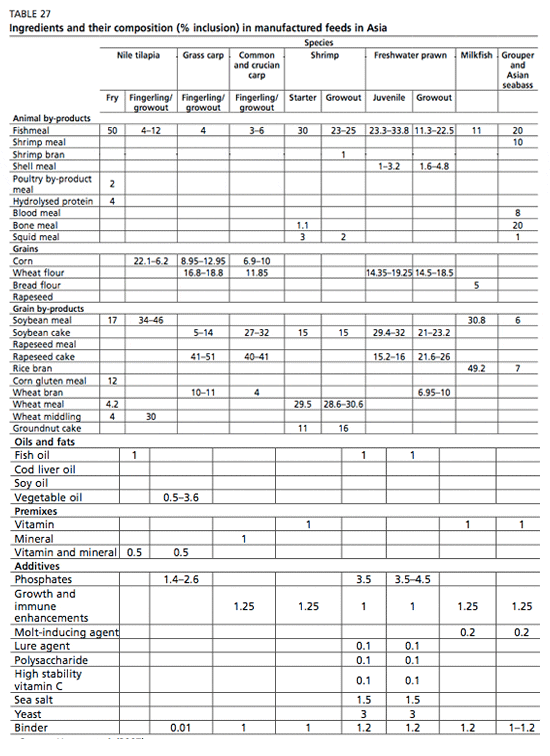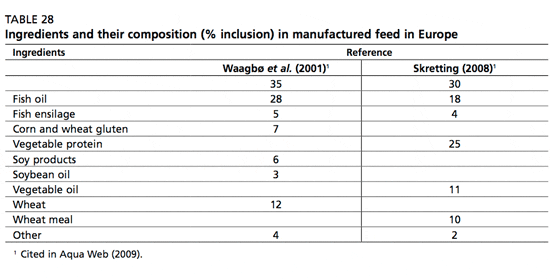In general, feeds and feeding practices vary according to the farming system, species under culture and stocking intensities.
Traditional extensive farming systems, in which fish growth and production are dependent on consumption of natural food organisms in water, use no feed or fertilizer. In some cases, these systems use chemical fertilizers and/or organic manures, which may also be added to stimulate and enhance natural productivity of pond water. In more intensively stocked farming systems, fertilizers and supplementary or complete feeds are used.
Feeds range from single component feeds available on-farm such as grass or rice bran to farm-made formulated feeds and commercial feeds. Feeds also can be simple farm made moist or dry aquafeeds or formulated commercially made aquafeeds. However, there is no clear definition for what is farm-made and non-farm made aquafeed and non-farm made aquafeeds.
FAO suggests that farm-made feeds be defined as feeds in pellet or other forms, consisting of one or more artificial and/or natural feedstuffs, produced for the exclusive use of a particular farming activity and not for commercial sale or profit. Kitchen waste may also be considered as one of the types of farm-made aquafeed as per FAO definition as it contains one or more natural feedstuffs in non- pellet form.
De Silva and Hasan (2007) suggest that mixtures of ingredients subjected to some form of processing (simple mixing, grinding and cooking) done on-farm or in small processing plants are generally regarded as farm-made aquafeeds and are often the mainstay in small-scale semi-intensive aquaculture practices. Formulated commercial feeds are composed of several ingredients, mixed in various proportions to complement each other, and form a nutritionally complete compounded diet. De Silva and Hasan (2007) categorized Asian aquafeeds into the following four groups.
- materials and/or ingredients of plant origin that are used singly or in combination with others (of plant or animal origin) but with little or no processing;
- materials of animal origin, primarily trash fish, that are used singly or in combination with others but with little or no processing;
- mixtures of ingredients that are subjected to some form of processing (simple grinding, mixing and cooking), resulting in a moist dough or in simple pellets; and
- feeds that are manufactured in industrial feed milling plants and are distributed and sold using conventional market chains.
A very wide range of ingredients is used to prepare farm-made aquafeeds. They include aquatic and terrestrial plants (duckweeds, Azolla, water hyacinth, etc.), aquatic animals (snails, clams, etc.) and terrestrial-based live feeds (silkworm larvae, maggots, etc.), plant processing products (de-oiled cakes and meals, beans, grains and brans) and animal-processing by-products (blood and feather meal, bone meal, etc.).
Vegetable ingredients are used singly or in combination with other ingredients of plant or animal origin as feeds with no or little processing in small-scale aquaculture at the lower end of semi-intensive practices, while material of animal origin such as trash fish is used singly or in combination with other ingredients with no or little processing at the upper end of semi-intensive practices (De Silva and Hasan, 2007).
Usually in intensive practices, commercial complete feeds are used. Irrespective of the feed category, the majority of the ingredients used in the feeds, particularly in categories (iii) and (iv) above, are fairly common ingredients and include fishmeal, soybean meal, various oilseed cakes (De Silva and Hasan, 2007). According to the FAO (2008b), aquaculture used 56 percent (3 million tonnes) of world fishmeal production in 2006 and 87 percent (800 000 tonnes) of fish oil production. Tacon (2008) puts this even higher, at 3.7 million tonnes of meal and 840 000 tonnes of oil.
For Asia as a whole, the situation is further exacerbated as its contribution to the world supply of these three principal ingredients is minimal in comparison to the proportion that is used by the regional animal feed industry (De Silva and Hasan, 2007). For example, while Asia produces only 17 percent of the global fishmeal supply, it consumes 47 percent of it.





Ingredients commonly used as nutrient sources are given in Table 24. Species-specific composition of main nutrients used in formulated commercial fish feeds in Asia and in Europe are given in Tables 25 and 26. In terms of ingredients used in commercial aquafeeds, Asia and Europe do not differ much (Tables 27 and 28). Irrespective of the region, the commercial aquafeeds largely depend on soybean products and corn or wheat products.
Additives are mainly used in high-value shrimp aquaculture in Asia. Apart from materials of animal and plant origin used as ingredients in aquafeeds, trash fish still remains the traditional feed for high-value marine carnivorous fish throughout the Asia-Pacific region and is likely to remain so for some time.
They are currently an indispensable feed for carnivorous fish and are also used in farm-made feeds for omnivorous species in some countries such as China, Viet Nam and Indonesia. It has been estimated that Viet Nam uses nearly 900 000 tonnes of trash fish and China will require approximately 4 million tonnes of trash fish by 2013 to sustain marine cage culture activities (De Silva and Hasan, 2007). However, the depleting availability of trash fish is considered one of the most serious constraints for aquaculture development in Viet Nam. The supply of trash fish in Asia is highly seasonal and dwindling (Edwards, Tuan and Allan, 2004).
Their efficacy as an aquafeed is debateable and their preferred use appears in many instances to be based more on farmer perceptions than economic reality (De Silva and Hasan, 2007). Moreover, the fishmeal manufactured mainly from trash fish, spoiled fish and processing waste is inferior in quality and often contains high levels of histamine and cadaverine substances (Hung and Huy, 2007).
Dependency on trash fish may continue with the expansion of marine cage aquaculture despite the socio-economic and environmental consequences of using trash fish and feed. However, because of the negative consequences for sustainability of the use of trash fish in terms of:
- the impact on near-shore fishery stocks;
- damage to the coastal environment;
- their potential to introduce disease in the cultured fish;
- inconsistent and inferior quality; and
- depleting availability, the growth of high-value marine carnivores will have to depend on commercial complete feeds sooner rather than later.
Further Reading
| - | You can view the full report by clicking here. |

